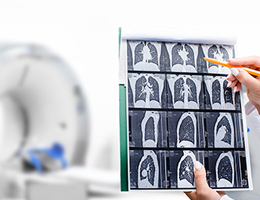
Nov. 16, 2023—In the United States, lung cancer takes more lives than any other type of cancer, according to the American Cancer Society (ACS). One reason is that it often doesn't cause symptoms in its early stages—when it's easier to treat. Screenings save lives by finding lung cancer sooner, before symptoms start.
That's why the ACS and the U.S. Preventive Services Task Force (USPSTF) recommend annual low-dose CT (LDCT) scans for many smokers and ex-smokers over age 50.
The facts about lung cancer screenings
If you have a history of smoking, you might be wondering if screening is right for you—and what to expect when you have it done. Here are five key facts to keep in mind:
1. Screening boosts survival rates. LDCT lung cancer screenings find more than 50% of lung cancers early enough for treatment to cure them. Only 25% of lung cancer is found at this early stage without screening.
2. Most screenings don't find cancer. Just because you're high-risk doesn't mean you have lung cancer. According to the American Lung Association, only 2% to 3% of LDCT screenings detect cancer. And that number goes down further when screenings are repeated over time. In most cases, what a screening gives you is peace of mind.
That said, LDCT screenings do sometimes find false positives—nodules, or areas of abnormal tissue, that turn out not to be cancer. About 95% of the nodules that scans show are not cancer. But they may lead to follow-up tests or scans to rule out cancer.
3. The scan is quick and painless. There's nothing to swallow and no injection beforehand. Expect to lie down and raise your arms over your head. You may be asked to hold your breath for a few seconds at a time. There will be a technologist there to walk you through each step of the process.
4. Screening starts at 50. Both the USPSTF and the ACS recommend that people at high risk for lung cancer start screening with LDCT at age 50. If you smoke or have a history of smoking, ask your doctor about your lung cancer risk and whether it's time to start screening.
5. Ex-smokers still benefit from screening. According to the new ACS recommendations, if you're between 50 and 80 years old and you smoked for 20 pack-years, you should consider a yearly LDCT scan—no matter how long ago you quit.
How do you calculate your pack-years? Multiply the number of packs (20 cigarettes) you typically smoked per day by the number of years you smoked at that rate. For example, a person who smoked a pack a day for 20 years and a person who smoked two packs a day for 10 years each smoked for 20 pack-years.
Should you be screened?
Our interactive assessment can help you decide. Share the results with your doctor. They can help you weigh the risks and benefits so you can make the choice that's right for you.
Sources
- American Cancer Society. "Lung Cancer Early Detection." https://www.cancer.org/cancer/types/lung-cancer/detection-diagnosis-staging/detection.html.
- American Lung Association. "Is Lung Cancer Screening Right for Me?” https://www.lung.org/lung-health-diseases/lung-disease-lookup/lung-cancer/screening-resources/is-lung-cancer-screening-right.
- American Lung Association. "What to Expect from a Lung Cancer Screening." https://www.lung.org/lung-health-diseases/lung-disease-lookup/lung-cancer/screening-resources/what-to-expect-from-lung-cancer-screening.
- American Lung Association. "Why Lung Cancer Screening Isn't for Everyone." https://www.lung.org/blog/why-lung-cancer-screening.
- National Cancer Institute. "Lung Cancer Screening." https://www.cancer.gov/types/lung/patient/lung-screening-pdq.
- Radiologyinfo.org. "Lung Cancer Screening." https://www.radiologyinfo.org/en/info/screening-lung.